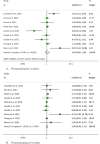Consumption of fast foods and ultra-processed foods and breast cancer risk: a systematic review and meta-analysis
- PMID: 40598414
- PMCID: PMC12210537
- DOI: 10.1186/s41256-025-00425-x
Consumption of fast foods and ultra-processed foods and breast cancer risk: a systematic review and meta-analysis
Abstract
Background: The increasing consumption of fast foods (FFs) and ultra-processed foods (UPFs) worldwide has raised concerns due to their association with carcinogenic compounds and potential links to various cancers. However, this evidence about breast cancer risk remains inconsistent. This study aimed to meta-analyze the association between FFs and UPFs consumption and the risk of breast cancer in females.
Methods: A comprehensive search on online databases was conducted from inception to May 2025, and relevant study data were extracted. The meta-analysis utilized odds ratio (OR) with 95% confidence interval (CI) as effect size measures. Subgroup analyses, heterogeneity assessment, publication bias, and sensitivity analyses were performed to ensure robustness. All statistical analyses were conducted using STATA.
Results: The pooled analysis of 17 observational studies showed a significant association between the highest FFs and UPFs consumption and increased breast cancer risk (OR 1.25, 95% CI [1.09-1.43], p = 0.001). Subgroup analysis revealed a significant positive association between FFs and UPFs consumption and breast cancer risk in case-control studies, but not in cohort studies or menopausal status and a significant association was observed in studies with sample sizes > 1000 and < 1000. Furthermore, the association was significant in Latin America when BMI adjustment was considered for 'yes' and 'no'.
Conclusions: This meta-analysis identified a significant association between the consumption of FFs and UPFs and an increased risk of breast cancer, with high intake linked to a 25% greater risk. These findings suggest that diets high in UPFs may play a role in breast cancer development. As UPF consumption continues to rise, public health strategies and regulatory policies targeting food processing, marketing, labeling, and accessibility are essential for cancer risk reduction and prevention.
Keywords: Breast cancer; Epidemiology; Fast food; Nutrition; Processed food; Risk.
© 2025. The Author(s).
Conflict of interest statement
Declarations. Ethics approval and consent to participate: Not applicable. Consent for publication: Not applicable. Conflict of interests: The authors declare no conflict of interest.
Figures








Similar articles
-
Association between higher consumption of ultra-processed foods and risk of diabetes and its complications: A systematic review & updated meta-analysis.Metabolism. 2025 Apr;165:156134. doi: 10.1016/j.metabol.2025.156134. Epub 2025 Jan 21. Metabolism. 2025. PMID: 39848440
-
Ultra-processed foods and human health: An umbrella review and updated meta-analyses of observational evidence.Clin Nutr. 2024 Jun;43(6):1386-1394. doi: 10.1016/j.clnu.2024.04.016. Epub 2024 Apr 18. Clin Nutr. 2024. PMID: 38688162
-
Selenium for preventing cancer.Cochrane Database Syst Rev. 2018 Jan 29;1(1):CD005195. doi: 10.1002/14651858.CD005195.pub4. Cochrane Database Syst Rev. 2018. PMID: 29376219 Free PMC article.
-
Ultra-Processed Food and Chronic Kidney Disease Risk: A Systematic Review, Meta-Analysis, and Recommendations.Nutrients. 2025 Apr 30;17(9):1560. doi: 10.3390/nu17091560. Nutrients. 2025. PMID: 40362869 Free PMC article.
-
Nutritional interventions for survivors of childhood cancer.Cochrane Database Syst Rev. 2016 Aug 22;2016(8):CD009678. doi: 10.1002/14651858.CD009678.pub2. Cochrane Database Syst Rev. 2016. PMID: 27545902 Free PMC article.
References
-
- Dianatinasab M, Rezaian M, HaghighatNezad E, Bagheri-Hosseinabadi Z, Amanat S, Rezaeian S, et al. Dietary patterns and risk of invasive ductal and lobular breast carcinomas: a systematic review and meta-analysis. Clin Breast Cancer. 2020;20(4):e516–28. - PubMed
Publication types
MeSH terms
LinkOut - more resources
Full Text Sources
Medical
Research Materials

